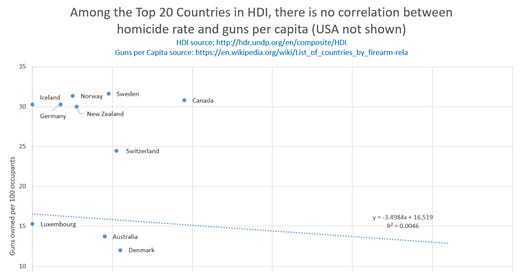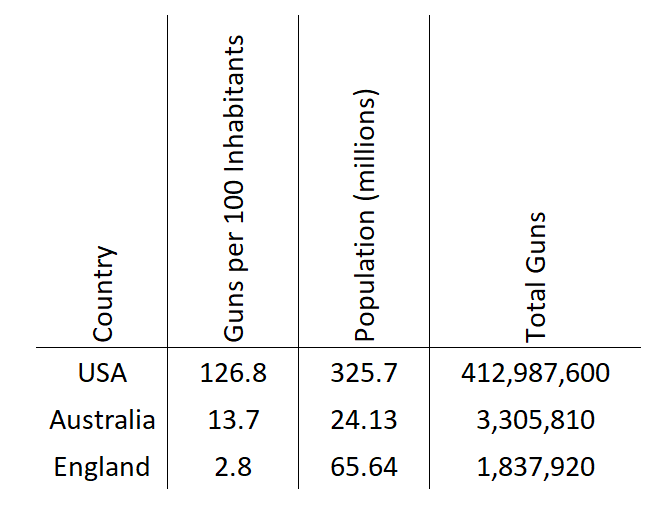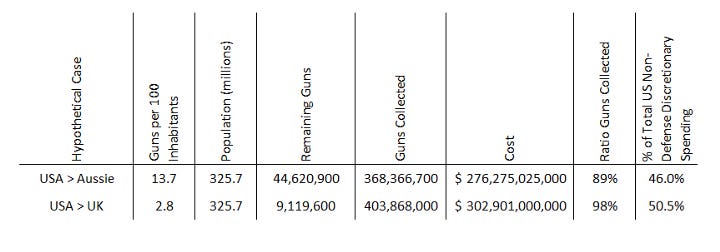The Magic Gun Evaporation Fairy
Three Reasons Why Gun Ownership Rates From Other Countries Don't Matter
This article originally appeared on Medium March 30, 2018. On December 11 2020, a cross national multivariate study of international gun ownership rate and gun crime rate confirmed it.
In my first article on Medium, I pointed out the profound lack of clear correlation between gun ownership rate and gun homicide rate on a state by state basis in the USA, as well as a similarly profound lack of correlation between guns per capita and gun homicide rate globally. This lack of correlation holds specifically within Europe, among countries with low homicide rates, and among countries with high homicide rates. We need to speak about “why,” because that will be useful to us later as we continue to apply critical thinking to American gun policy. That article has a lot of graphs that are useful in understanding the real data, but I think it’s important to revisit the concepts within it, and drill something home.
Reason #1: Gun Homicide Doesn’t Correlate with Guns Per Capita
I monitored some of the social media traffic surrounding the first article, and saw this graphic presented as a response to it:
A google image search indicates the image was recovered from here. I don’t know it’s origin, and some of the data in it is a little old, but it will do nicely as an example. Instead of our other data sets, this one is gathering countries from the Human Development Index, which is a very complicated way to rank countries on a scale of “awesome” to “suck,” based on a wide array of variables chosen by team members from the United Nations Development Programme. I don’t object to this; it seems like a worthy endeavor and an interesting way to spend time.
Let’s talk data visualization. The presentation of the graph above draws your eye to the USA data point, because so much ink space is spent on the USA, and that leads our intuitions to think that these things are correlated. But all the image really shows is that the USA is an outlier. It’s a data point so extreme that including it in the set would bias the data. If there were a general relationship between gun homicide rate and guns per capita, then it should clearly be there whether the outlier is included or not. So we do this, and we check for any correlation.
Garbage. Negatively correlated, with an R² value less than five thousandths. Before you cry about not including the USA in the graph, do it yourself with the USA in there. You’ll see there’s still no correlation, the graph is just less readable.
This realization might be a bit alarming to you if you’re an Australian who traded your guns in a decade ago. But unlike the first article where we kept pointing at garbage and repeatedly saying “garbage!” let’s instead spend a little time discussing why it’s garbage.
Israel is way out to the right. Low guns-per-capita (despite the common right-wing media narrative) but a high firearm homicide rate. Well that’s easy to explain. Israel has this whole Palestinian thing going on. You might have heard about it.
Let’s compare Japan, South Korea, and Singapore. They are all right in the same vicinity on the graph. Although I’ve been informed that these countries occasionally aren’t friendly with each other, they are nonetheless similar countries culturally. Their guns-per-capita and homicide rates may be similar, but those rates are also a reflection of their culture.
Now look at Germany and Ireland. Germany has almost eight times more guns than Ireland, but Ireland has three and a half times more gun homicides than Germany, by rates. Why is that? Well, let’s be honest with ourselves for just this once on the internet. It’s because Germany is full of Germans, and Ireland is full of Irish. Culture.
Consider some off-graph data for a moment. If we combine the USA suicide rate and homicide rates into one rate, of all methods and not just guns, we get 4.9 + 13.4 = 18.3. South Korea’s suicide rate alone is 24.1 per 100k, and they’ve got almost no guns. Waive it away though, because oh, that’s cultural.
Now let’s look at Ye Olde Red White and Blue Outlier: The United States of America. Let’s compare our country to the other countries in the plot. We got the country kicked off by repeatedly coating tax collectors with searing hot tar and covering them with chicken feathers, moved on to shooting them, and then we won the war in no small part by applying the emerging concept of “interchangeable parts” to firearms. You’ve heard that AR-15s are basically build-a-bear rifles made of interchangeable parts, right? Since our storied and violent beginning, we’ve been at war 225 of our 242 years of existence. We nuked two cities. We have troops stationed in 150 different countries. When we want to eradicate poverty, or illicit drugs, or terrorism, what do we do? Declare “war” on them. At the beginning of every baseball game, we hoist a flag with a star for every territory taken by force from the natives and singing a song about rockets and bombs.
I’m writing this article on Tuesday, March 27th, 2018. If I decided to waste my life watching prime time TV, which I don’t advocate, I could start tonight and watch a continuous string of violence through the end of the week, never having to leave the Big Four Plus PBS. Check it out:
Tonight — NCIS, Lethal Weapon, NCIS: New Orleans
Wednesday — Empire, SEAL Team, WWII Mega Weapons
Thursday — Gotham, WWII Mega Weapons (round two!), S.W.A.T.
Friday — Blindspot, Hawaii Five-O (or Agents of S.H.I.E.L.D. or 9–1–1), Blue Bloods
Violence permeates our collective zeitgeist. Comparing us to other HDI Index countries simply makes no sense, culturally. We’re an outlier for a reason. And even if we weren’t, gun homicides do not correlate bivariately with gun ownership, nor with guns per capita.
Reason #2: Murder Stoichiometry
In a chemical reaction, you mix two or more reactants, and you get one or more products. Like this:
NaHCO3 + HC2H3O2 → NaC2H3O2 + H2O + CO2
Or more colloquially,
(baking soda) + (vinegar) → (sodium acetate) + (water) + (bubbles)
Stoichiometry is the math of balancing the thing out, so that all the reactants are consumed, and we can know exactly how much of each product is made. In this assuredly familiar case, you put the baking soda in the bottom of a cup, you pour vinegar in, it foams, you pour more, it foams, etc. When the last grain of baking soda reacts, dumping more vinegar in won’t make more bubbles. You could dump in a whole cup more of vinegar, or a pitcher of it, or a bathtub of it, but you get no more bubbles.
Gun crime is a socio-logistic chemistry reaction with two reactants and one product.
(criminal) + (gun) → (gun crime)
If this sociological chemistry equation were perfectly balanced, there would be one gun per criminal and one criminal per gun. In that special case, every gun we removed from the reaction would mean one less gun crime. If we removed all guns, no gun crime. But look at the other direction. If there were so many guns that any criminal could find a gun, then adding more guns would not lead to more gun crime. The guns are the vinegar, and the bubbles are the crime. Dumping more vinegar past a certain point doesn’t make more bubbles, and we as a country are way, way past that point with guns.
Or think of it this way. I postulate that any criminal, today, could find ten guns if he or she needed to. If we were to eliminate half the guns in the country, they could only find five. All they need is one. That’s obviously not exactly analogous to how guns are acquired, because guns are not evenly mixed in some kind of National Erlenmeyer Flask, but once we vastly exceed a saturation point the analogy works well.
“Vastly exceeding the saturation point” is a bold postulation. Is it real?
Reason #3: We Can’t Get There From Here Anyway
How many guns are out there? Well, nobody knows for sure, because many people who buy guns don’t want you to know they have them, specifically so you can’t come seize them. It’s a thing with them. I may touch on why it’s a thing in a future article, but for now, accept at face value that it’s a thing.
The Congressional Research Service, who we presume has their act together, said in their November 14, 2012 paper that there were approximately 310 million guns here in 2009. This paper is thorough, and fantastic, and covers a wide range of topics in a relatively nonpartisan fashion. You should bookmark it whether you’re a pro-gun person or a guns-are-bad person. I’m skeptical of that number though.
Here is an interesting article by a former spec-ops weapons man, who gives us an extensive read into the literature, comparing the different numbers from different sources, with some commentary. He cites the ATF’s “Access 2000” system, which allows voluntarily participating manufacturers, importers, and wholesalers, to enter their firearms straight into an ATF managed database. Manufacturers choose to use this system so they never have to bother with the ATF hassling them during an investigation, because the ATF will already have access to their records. In 2015, he found that the A2K system included 252,443,229 records voluntarily input into the system by private manufacturers and wholesalers, each representing a unique gun serial number. That system has only been operational since 2000. Do we really think 252 million of the “300 million” guns in the country passed through the hands of those individual dealers since 2000? Not likely. By his take, it’s quite possible that the total number of guns is vastly under reported, and the true number is between 329 million and 660 million, with a reasonable guess being 413 million firearms. He could be wrong, but I find his argument compelling. We will use this number, which converts to 126.8 guns per 100 inhabitants. Here’s a comparison table.
Spend a second digesting the sheer magnitude of those numbers before we proceed.
The “But Australia!” Scenario
The now tremendously famous Australian Gun Buyback program of 1996 led to the collection of 700,000 firearms, at the cost of $230 million, approximately $328 per gun. Australia’s gun buyback program didn’t buy all their guns back, or even most of them. It only collected somewhere between 20% and 40% of their firearms. Most were left in place. To get any better than those collection rates we will have to pay a lot more. $328 is the very bottom end of what a gun costs, and many of our guns are worth tremendously more than that.
To get the United States down to Australia’s guns-per-capita ratio of 13.7 per 100 inhabitants, we would have to collect 368,366,700 guns, or 89% of the total guns in the entire country. We’d probably have to pay $750 per gun on average to get them, at least, and even that wouldn’t get us close enough to the target number. A lot would have to be collected by force. The buyback alone, at that price point, would cost a quarter of a trillion dollars, which is 46% of all non-defense discretionary spending. And it wouldn’t do anything to our homicide numbers because homicide isn’t correlated meaningfully to guns per capita.
But “go big or go home,” so let’s shoot for the holy grail: England.
The “But England!” Scenario
To get the USA to England’s guns per capita ratio, we’re looking at spending almost a third of a trillion dollars, over half of the country’s non-defense discretionary spending. We’d be collecting 404 million guns, leaving only 9 million in circulation, which means 98% of the guns in the country would have to be collected.
And how would we propose to execute that plan, exactly? It won’t be peaceful.
Those targets are not achievable on a completely voluntary basis. Not even close. They would have to be enforced somehow. Someone along the way might get shot, or burned to a crisp, or you know, the usual. The scene in the inner cities won’t be pretty.
The Punchline
There is a statistically sound case that no clear relationship exists between gun proliferation and gun homicide rate. But even if we don’t believe that case, there is no path to get the United States of America to a guns-per-capita ratio on par with other countries. It is not remotely feasible. We could have eight moon bases for the same fiscal outlay, to say nothing of the civil strife.
And since they are impossible targets, they do not matter. We should stop bringing them up.








> Germany has almost eight times more guns than Ireland, but Ireland has three and a half times more gun homicides than Germany, by rates. Why is that? Well, let’s be honest with ourselves for just this once on the internet. It’s because Germany is full of Germans, and Ireland is full of Irish.
To be fair to the Germans and the Irish, this is no longer strictly true about either of their countries...
how relevant this stays.